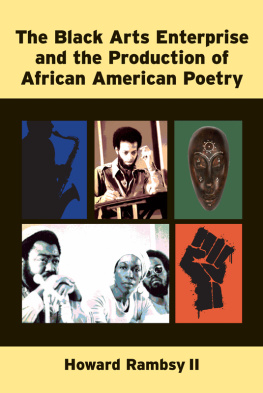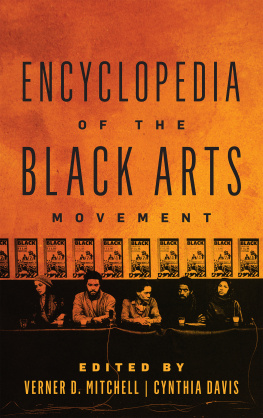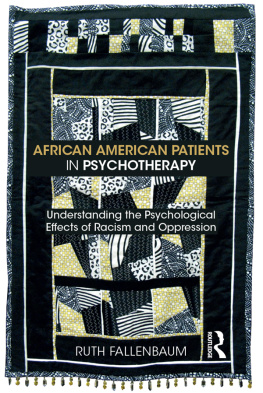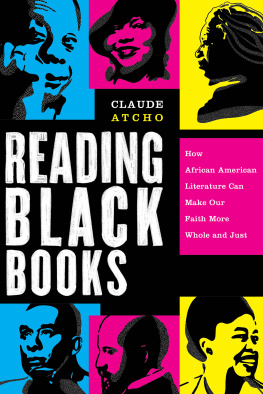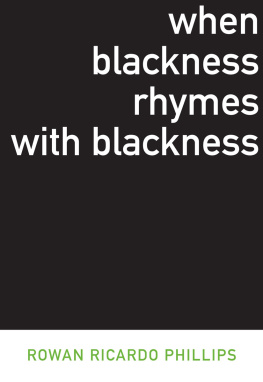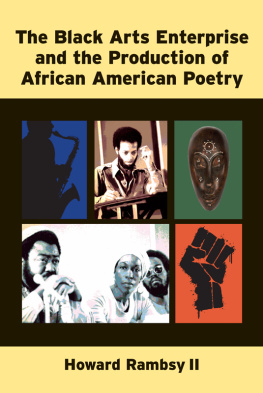Rambsy - The Black Arts Enterprise and the Production of African American Poetry
Here you can read online Rambsy - The Black Arts Enterprise and the Production of African American Poetry full text of the book (entire story) in english for free. Download pdf and epub, get meaning, cover and reviews about this ebook. City: United States, year: 2013, publisher: University of Michigan Press, genre: Art. Description of the work, (preface) as well as reviews are available. Best literature library LitArk.com created for fans of good reading and offers a wide selection of genres:
Romance novel
Science fiction
Adventure
Detective
Science
History
Home and family
Prose
Art
Politics
Computer
Non-fiction
Religion
Business
Children
Humor
Choose a favorite category and find really read worthwhile books. Enjoy immersion in the world of imagination, feel the emotions of the characters or learn something new for yourself, make an fascinating discovery.
The Black Arts Enterprise and the Production of African American Poetry: summary, description and annotation
We offer to read an annotation, description, summary or preface (depends on what the author of the book "The Black Arts Enterprise and the Production of African American Poetry" wrote himself). If you haven't found the necessary information about the book — write in the comments, we will try to find it.
Rambsy: author's other books
Who wrote The Black Arts Enterprise and the Production of African American Poetry? Find out the surname, the name of the author of the book and a list of all author's works by series.
The Black Arts Enterprise and the Production of African American Poetry — read online for free the complete book (whole text) full work
Below is the text of the book, divided by pages. System saving the place of the last page read, allows you to conveniently read the book "The Black Arts Enterprise and the Production of African American Poetry" online for free, without having to search again every time where you left off. Put a bookmark, and you can go to the page where you finished reading at any time.
Font size:
Interval:
Bookmark:

First paperback edition 2013
Copyright by the University of Michigan 2011
All rights reserved
Published in the United States of America by
The University of Michigan Press
Manufactured in the United States of America Printed on acid-free paper
Printed on acid-free paper
2016 2015 2014 2013 5 4 3 2
No part of this publication may be reproduced, stored in a retrieval system, or transmitted in any form or by any means, electronic, mechanical, or otherwise, without the written permission of the publisher.
A CIP catalog record for this book is available from the British Library.
Library of Congress Cataloging-in-Publication Data
Rambsy, Howard.
The black arts enterprise and the production of African American poetry / Howard Rambsy, II.
p. cm.
Includes bibliographical references and index.
ISBN 978-0-472-11733-8 (cloth : acid-free paper)
1. American poetryAfrican American authorsHistory and criticism. 2. PoetryPublishingUnited StatesHistory20th century. 3. African AmericansIntellectual life20th century. 4. African Americans in literature. I. Title.
PS310.N4R35 2011
811'.509896073dc22 2010043190
ISBN 978-0-472-03568-7 (pbk. : alk. paper)
ISBN 978-0-472-12005-5 (ebook)
Cover illustrations: photos of writers (1) Haki Madhubuti and (2) Askia M. Tour, Mari Evans, and Kalamu ya Salaam by Eugene B. Redmond; other images from Shutterstock.com: jazz player by Ian Tragen; African mask by Michael Wesemann; fist by Brad Collett.
Dedicated to Donald Garcia, Maryemma Graham, Cynthia Spence, Mae G. Williams, and Jerry W. Ward Jr.
A Preface
We Will Change the World Before Your Eyes
At some point during the late 1960s, black poetry reached a tipping point. No fewer than sixty anthologies featuring African American verse appeared between 1965 and 1976 alone. This flourishing of black poetry was Harlem Renaissance 2.0 and then some. A large number of African American poets enjoyed unprecedented popular and critical successtheir images regularly appeared in magazines, their words were frequently published in periodicals, and their voices resonated alongside the sounds of jazz musicians and gospel choirs on albums. Their poetry and pronouncements were sometimes forceful, sometimes outrageous, and often infused with a militant, black nationalist ethos. We are building publishing houses, and newspapers, and armies, and factories, wrote Amiri Baraka. We will change the world before your eyes. An explanation of the forces that created an environment for the display of these kinds of provocative statements constitutes the major focus of this study.
The Black Arts Enterprise and the Production of African American Poetry illuminates the often underexamined publishing factors that facilitated one of the most decisive moments in American literary history. In particular, this book explains how a diverse range of writers, editors, publishers, illustrators, and musicians collaborated to enact a dynamic cultural movement. The central argument of this project is that the coordinated and innovative efforts of black artists and their supporters greatly increased the visibility and implications of African American poetry. An examination of the productionnot merely the compositionof black verse from the late 1960s to the mid-1970s reveals what made the Black Arts Movement such an enduring cultural enterprise.
Years ago, I informed the people in my circles that I was writing a book. They somehow misheard me and thought I said I was building a house. So for some time now, they have been offering all kinds of assistance and materials for a project much larger than a study of poetry and publishing history.
First, my mom and dad, my siblings, Kenton and Phillis, and my extended family gave invaluable support when I was laying my earliest groundwork. Later, at Pennsylvania State University, Bernard Bell, Keith Gilyard, William Harris, and James Stewartall wonderful buildersprovided me with formal direction on developing a solid foundation. Later still, Aldon Nielsen, Lovalerie King, Earleen Patterson, James Smethurst, Vorris Nunley, Stefan Bradley, and my big sister Alondra Nelson gave me stimulating and diverse models for envisioning the types of structures that I wanted to create.
I have benefited from a broad range of building support, including grants from the Woodrow Wilson Foundation and Southern Illinois University Edwardsville (SIUE) and assistance from Julie Hansen in tracking down rare materials. Emily and Scott VanDette, my friends and colleagues at SIUE and in the College Language Association, and my fellow travelers with the SIUE Black Studies Program, were tremendously supportive at all stages of the process. LeAnn Fields and the good people at the University of Michigan Press have generously provided a platform for what I produced.
At a crucial moment in the project, I met Psyche Southwell, and her generosity and intellectualism inspired me to think and then build in new and exciting ways. Finally, I could never say enough about all I have gained observing and tracing the workings of that wonderful East St. Louis, world-traveling architect Eugene B. Redmond.
A Group of Groovy Black People
In the June 1965 issue of Liberator, Larry Neal described the arrival of the Black Arts School in Harlem, which opened on April 30 with an explosive evening of good poetry. According to Neal, however, the most memorable event of the black arts weekend was the parade held that Saturday morning in Harlem. Imagine jazz musicians, African dancing, and a group of groovy black people swinging down Lenox Avenue, wrote Neal. It was Garvey all over again. It was informal and spontaneous and should illustrate something of the potential for creative encounter existing in our community. Just in case readers needed help envisioning the scene, a photograph accompanied the story showing two men leading a group down the middle of the street, carrying a large flag that read, The Black Arts Repertory Theatre/School. The caption for the photo identified LeRoi Jones and Hampton Clanton leading the Black Arts parade down 125th Street, New York City. They were on a mission, on the move. As a result, when Neal assessed the activities of these groovy black people a few years later, he defined their efforts as a movement, a Black Arts Movement.
The operation of the Black Arts School in Harlem was relatively brief; however, the spirit of activism and explosiveness expressed by those black artists swinging down Lenox Avenue typified the vitality and outlook of African American writers and organizers across the country during the time period. Those writers who ventured to take literary art to the people in such dramatic fashion suggested that they wanted to expand and transform conventional notions about what it meant to be artists. Not content with being only composers of verse and prose, they sought to become active on multiple fronts in the processes of artistic production. In fact, given Larry Neals abilities crafting insightful essays about the nature of black art, Amiri Barakas talents constructing compelling artistic productions, and Hoyt Fullers and Dudley Randalls significant work designing sites of publication, there is little wonder as to why observers often refer to these figures, among others, as architects of the Black Arts Movement. Their collective artistic activities and organizing efforts were integral to the construction of an extensive series of interconnected cultural productions.
During the 1960s, a large number of poets achieved unprecedented levels of exposure in the literary marketplace and academy. This is not to say that the Harlem Renaissance was anything less than a crucial moment in American and African American literary history. The New Negro Movement of the 1920s certainly paved the way for the New Black Poetry of the 1960s. Yet the tremendous body of writings produced by and about African American poets between 1965 and 1976 was unparalleled. Even if we accept the assessment of critic Henry Louis Gates Jr. that the Black Arts Movement was the most short-lived of all African American literary movements, we would be hard-pressed to identify a moment in literary history with such a remarkable and memorable attentiveness to black poets and poetry.
Font size:
Interval:
Bookmark:
Similar books «The Black Arts Enterprise and the Production of African American Poetry»
Look at similar books to The Black Arts Enterprise and the Production of African American Poetry. We have selected literature similar in name and meaning in the hope of providing readers with more options to find new, interesting, not yet read works.
Discussion, reviews of the book The Black Arts Enterprise and the Production of African American Poetry and just readers' own opinions. Leave your comments, write what you think about the work, its meaning or the main characters. Specify what exactly you liked and what you didn't like, and why you think so.

